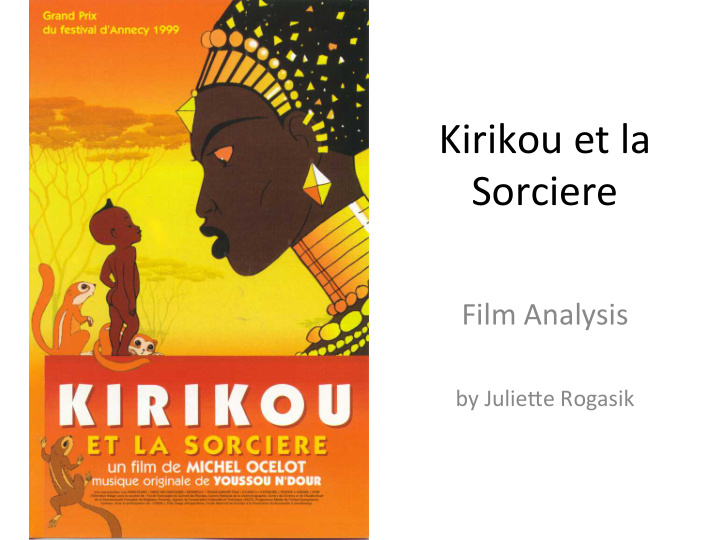



Kirikou ¡et ¡la ¡ Sorciere ¡ Film ¡Analysis ¡ ¡ by ¡Julie6e ¡Rogasik ¡
Michel ¡Ocelot ¡ Les ¡Trois ¡Inventeurs ¡(1980) ¡ ¡ Princes ¡et ¡Princesses ¡(2000) ¡ Born ¡in ¡France ¡in ¡1943 ¡and ¡grew ¡up ¡in ¡Guinea, ¡West ¡Africa ¡unHl ¡he ¡was ¡a ¡ • teenager ¡ Previously ¡known ¡for ¡his ¡silhoue6e/cut-‑out ¡animaHons ¡ •
Ocelot’s ¡style: ¡sHlls ¡from ¡Kirikou ¡
Cinematography ¡ UnconvenHonal ¡narraHve ¡space ¡(2D ¡hand ¡drawings ¡and ¡landscapes ¡that ¡look ¡ • like ¡cutouts ¡from ¡different ¡materials) ¡ – West ¡African ¡tradiHonal ¡art ¡is ¡made ¡from ¡dark ¡wood, ¡gold, ¡bronze ¡or ¡clay ¡ Décor ¡made ¡in ¡the ¡colors ¡and ¡textures ¡of ¡West ¡African ¡art ¡ • – Chief ¡decorator ¡is ¡sculptor ¡Anne-‑Lise ¡Koehler ¡
Yoruba ¡Water ¡Vessel, ¡13" ¡high, ¡rim ¡6 ¡1/2", ¡No. ¡72.3.114, ¡Ita ¡Yemoo ¡ Museum ¡of ¡Yoruba ¡Po6ery, ¡Ile ¡Ife, ¡Nigeria. ¡Photo ¡by ¡Ron ¡du ¡Bois, ¡ 1988. ¡
Karaba’s ¡hut ¡
EmoHon ¡ Karaba’s ¡scream ¡
“In ¡a ¡ moment, ¡that ¡ li6le ¡animal ¡ will ¡be ¡pinned ¡ to ¡the ¡ ground!” ¡ “How ¡strange ¡it ¡is, ¡to ¡ no ¡longer ¡feel ¡the ¡ slightest ¡suffering.” ¡
Long ¡takes: ¡20 ¡sec. ¡ 34 ¡sec. ¡ 20 ¡sec. ¡
Colonial ¡cinema? ¡ ExoHcism: ¡Africa ¡as ¡primiHve, ¡ • unchanging, ¡unspoiled ¡realm ¡ ( Encountering ¡the ¡Other(s), ¡ Gisela ¡ Brinker-‑Gabler) ¡ Samuel ¡Lelievre: ¡ • – Colonial ¡cinema ¡is ¡made ¡of ¡“images ¡coming ¡ from ¡outside” ¡while ¡African ¡cinema ¡is ¡made ¡ of ¡“images ¡coming ¡from ¡inside” ¡ Rousseau, ¡“The ¡Dream” ¡ Jackie ¡Huggings: ¡ • – “Whites ¡must ¡not ¡[take] ¡advantage ¡of ¡their ¡ privileged ¡speaking ¡posiHons ¡to ¡contract ¡an ¡ external ¡vision ¡of ¡‘us’ ¡which ¡may ¡pass ¡for ¡our ¡ ‘reality.’ ¡There ¡must ¡be ¡limits ¡to ¡the ¡ways ¡ our ¡worlds ¡are ¡re-‑wri6en ¡or ¡placed ¡in ¡ conceptual ¡frameworks ¡which ¡are ¡not ¡our ¡ own.” ¡ ¡ SHll ¡from ¡“Kirikou” ¡
What’s ¡unique ¡about ¡Kirikou ¡ “In ¡animaHon, ¡we ¡have ¡never ¡shown ¡Africans ¡in ¡Africa.” ¡(Ocelot) ¡ • Can ¡a ¡French ¡filmmaker ¡ever ¡narrate ¡Africa ¡without ¡this ¡process ¡ • automaHcally ¡becoming ¡a ¡mis-‑representaHon ¡or ¡an ¡extension ¡of ¡ colonialism? ¡ Aboriginal ¡filmmaker ¡and ¡historian ¡Frances ¡Peters ¡Li6le: ¡“SomeHmes, ¡you ¡ • just ¡have ¡to ¡be ¡a ¡good ¡filmmaker.” ¡ Naturalized ¡nudity, ¡images ¡of ¡birth, ¡emphasis ¡on ¡the ¡physical ¡body ¡ • (themes ¡unique ¡to ¡Africa) ¡ Recorded ¡in ¡Senegal ¡with ¡West-‑African ¡cast; ¡no ¡famous ¡French ¡actors ¡ • West-‑African ¡music ¡using ¡only ¡tradiHonal ¡instruments ¡ • “Homage ¡to ¡Africa,” ¡avoiding ¡WesternizaHon ¡ • Aware ¡of ¡problems ¡with ¡representaHon, ¡Ocelot ¡did ¡not ¡want ¡to ¡be ¡telling ¡ • a ¡story ¡that ¡was ¡“not ¡his ¡to ¡tell,” ¡so ¡most ¡of ¡the ¡plotline ¡is ¡from ¡his ¡own ¡ imaginaHon ¡
NarraHng ¡the ¡NaHon ¡in ¡a ¡‘Post-‑ NaHonal’ ¡world ¡ Anthropologist ¡Renato ¡Rosaldo: ¡“[A]ll ¡of ¡us ¡inhabit ¡an ¡interdependent ¡late ¡ • 20th ¡century ¡world, ¡which ¡is ¡at ¡once ¡marked ¡by ¡borrowing ¡and ¡lending ¡ across ¡porous ¡cultural ¡boundaries, ¡and ¡saturated ¡with ¡inequality, ¡power, ¡ and ¡dominaHon.” ¡ Ocelot’s ¡film: ¡placing ¡us ¡in ¡the ¡conflictual ¡heart ¡of ¡his ¡experience ¡as ¡a ¡ • French ¡ciHzen ¡who ¡considers ¡himself ¡West-‑African ¡ Believable ¡portrayal: ¡The ¡“Hmeless ¡tale” ¡of ¡Kirikou ¡contains ¡disturbing ¡Hes ¡ • to ¡history ¡ – Burning ¡of ¡the ¡house ¡ – Karaba ¡capturing ¡the ¡children ¡in ¡the ¡tree-‑cage ¡ – The ¡story ¡of ¡Karaba’s ¡abuse ¡
TransnaHonality ¡ Giratri ¡Spivak’s ¡idea ¡of ¡planetarity: ¡The ¡boundaries ¡ • we ¡create ¡between ¡“self” ¡and ¡“other” ¡are ¡ ulHmately ¡ill-‑defined ¡ ¡ Tells ¡universal ¡morals ¡through ¡a ¡very ¡raw ¡mythical ¡ • framework, ¡giving ¡it ¡an ¡intrinsically ¡acultural ¡feel: ¡ – The ¡sorceress ¡is ¡mean ¡because ¡she ¡is ¡suffering ¡ – We ¡must ¡be ¡happy ¡the ¡way ¡we ¡are ¡ – The ¡greedy ¡creature ¡gets ¡thirsHer ¡the ¡more ¡he ¡drinks ¡ A ¡transnaHonal ¡film ¡by ¡default: ¡Funded ¡by ¡various ¡ • European ¡sources; ¡animated ¡in ¡France, ¡Hungary, ¡ Luxembourg ¡and ¡Latvia; ¡voices ¡recorded ¡in ¡Dakar ¡ Challenges ¡ideas ¡of ¡naHon ¡and ¡naHonal ¡idenHty ¡ • through ¡its ¡huge ¡success ¡in ¡France ¡(1.5 ¡million ¡ Hckets) ¡ – These ¡characters ¡have ¡become ¡anchored ¡in ¡French ¡ children’s ¡minds ¡as ¡characters ¡to ¡which ¡they ¡can ¡idenHfy ¡ – Kirikou’s ¡wise ¡grandfather ¡is ¡everybody’s ¡wise ¡grandfather ¡ – The ¡village ¡is ¡everybody’s ¡village ¡
Conclusion ¡ • Kirikou ¡does ¡re-‑imagine ¡and ¡universalize ¡the ¡ emoHons ¡of ¡the ¡trauma ¡of ¡West ¡Africans ¡in ¡a ¡ way ¡that ¡makes ¡it ¡relatable ¡to ¡a ¡global ¡ audience ¡rather ¡than ¡specific ¡to ¡indigenous ¡ West ¡African ¡experience, ¡but ¡this ¡does ¡not ¡ force ¡its ¡characters ¡into ¡two-‑dimensional ¡ paradigms. ¡ ¡
References ¡ Gisela ¡Brinker-‑Gabler, ¡“Encountering ¡the ¡Other(s): ¡Studies ¡in ¡Literature, ¡ • History, ¡and ¡Culture” ¡(SUNY ¡Press, ¡1995), ¡309. ¡ Samuel ¡Lelièvre, ¡“Diffuser ¡des ¡films ¡africains ¡en ¡Afrique,” ¡ Études ¡océan ¡ • Indien , ¡44 ¡(2010), ¡227-‑241. ¡h6p://oceanindien.revues.org/582 ¡ ¡ Jackie ¡Huggins, ¡Rita ¡Huggins ¡and ¡Jane ¡M. ¡Jacobs, ¡“Kooramindanjie: ¡Place ¡ • and ¡the ¡Postcolonial,” ¡ History ¡Workshop ¡Journal, ¡39 ¡(1995), ¡164-‑81. ¡ Raphaelle ¡Moine, ¡Alistair ¡Fox, ¡Michel ¡Marie ¡and ¡Hilary ¡Radner, ¡“A ¡ • Companion ¡to ¡Contemporary ¡French ¡Cinema” ¡(2014), ¡335-‑337. ¡ Henri ¡Rousseau’s ¡“The ¡Dream”: ¡ • h6p://www.nga.gov/content/ngaweb/features/slideshows/henri-‑ rousseau.html ¡ ¡ GC ¡Spivak ¡“Chapter ¡3: ¡Planetarity,” ¡from ¡ Death ¡of ¡a ¡discipline. ¡ (New ¡York: ¡ • Columbia ¡University ¡Press, ¡2003), ¡pp. ¡71-‑102. ¡ G. ¡Huggan, ¡“Ethnic ¡Autobiography ¡and ¡the ¡Cult ¡of ¡AuthenHcity” ¡in ¡ The ¡ • Postcolonial ¡ExoDc: ¡MarkeDng ¡the ¡Margins , ¡by ¡G. ¡Huggan ¡(Abingdon: ¡ Routledge, ¡2002), ¡pp. ¡155-‑176. ¡ Andréanszky, ¡Eugène. ¡“Cahier ¡De ¡Notes ¡Sur... ¡Kirikou ¡Et ¡La ¡Sorcière,” ¡ • Paris: ¡Les ¡Enfants ¡De ¡Cinéma. ¡
Recommend
More recommend